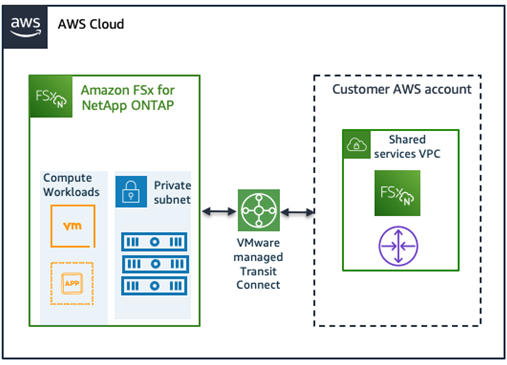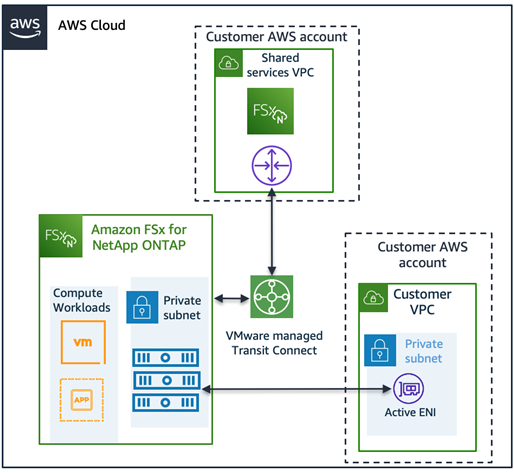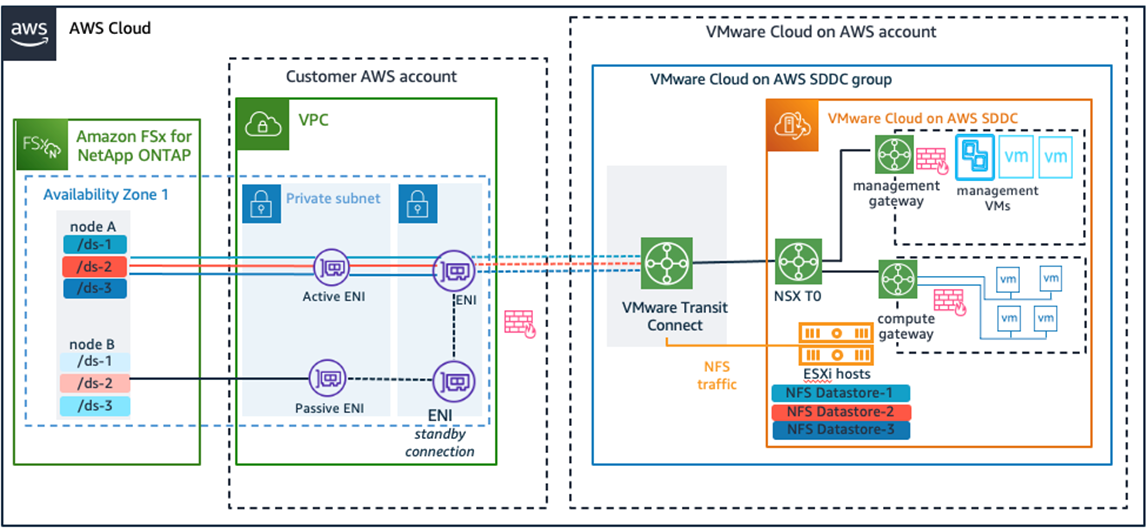AWS Partner Network (APN) Blog
Reduce Storage Costs with Single-Availability Zone Deployments for Amazon FSx for NetApp ONTAP Datastores
By Kiran Reid, Sr. Partner Solutions Architect – AWS
By Siegfried Eigler, Sr. Specialist Solutions Architect – AWS
By Pat Brandel, Sr. Product Manager – AWS
Amazon FSx for NetApp ONTAP is a storage service that allows customers to launch and run fully managed ONTAP file systems in the cloud. NetApp is an AWS Storage Competency Partner and ONTAP is NetApp’s file system technology that provides a widely adopted set of data access and data management capabilities.
At VMware Explore 2022, Amazon Web Services (AWS) and VMware announced the general availability of VMware Cloud on AWS integration with Amazon FSx for NetApp ONTAP.
VMware Cloud on AWS enables customers to extend their on-premises data centers and easily migrate workloads without having to convert machine image formats or undergo a re-platforming process.
In this post, we will review the benefits of single-Availability Zone (AZ) deployments for Amazon FSx for NetApp datastores and review which workloads they are best suited for. Single-AZ file systems provide a lower-cost storage option for use cases that do not require the data resiliency model of a multi-AZ file system, while offering all of the same data management capabilities and features.
Integration Overview
There are two account connectivity options for enabling storage provisioned by Amazon FSx for NetApp ONTAP to be made available for mounting as a datastore to a VMware Cloud on AWS software-defined data center (SDDC). Both options use a dedicated Amazon Virtual Private Cloud (Amazon VPC) across two AWS Availability Zones for the FSx file system.
The first option is to create a new Amazon VPC with a subnet in the AZ under the same connected AWS account connected to the VMware-owned VPC using VMware Transit Connect.
Figure 1 – Storage under the same AWS connected account.
The second option is to create a new AWS account, which by default comes with an Amazon VPC for the region. Similar to the first option, one subnet in two AZs are required along with the VMware Transit Connect, which is used to attach this new VPC with the VMware-owned VPC.
Figure 2 – Enable storage in a new AWS account.
Customers leveraging this solution already have the flexibility to add customer-managed datastores to their existing SDDCs over the Network File System (NFS) protocol, giving them an elastic storage solution to support their growing workload needs.
What’s New?
AWS and VMware are now announcing that single-AZ file systems are available with VMware Cloud on AWS. More information is available on VMware techzone and in the VMware Cloud on AWS configuration documentation.
Like with a multi-AZ deployment, the subnet cannot be deployed in the connected VPC. Customers will now create a new VPC, with at least one subnet in the same AZ as the SDDC. FSx for ONTAP is then deployed in that VPC and connected to the SDDC via VMware Transit Connect.
Single-AZ Benefits
Single-AZ file systems are for deployments that do not require data resiliency across Availability Zones. Some of the use cases might be to run development, test workloads, and store secondary copies of data, and single-AZ file systems provide a lower-cost storage option for these use cases while offering the same data management capabilities and features.
Production workloads typically require high availability and durability across multiple AZs. Amazon FSx for ONTAP multi-AZ file systems offers a simple solution for these workloads by providing storage with built-in replication across AZs. However, with some workloads you may already have another copy of your data stored elsewhere (disaster recovery from on premises to AWS or across AWS regions, for example) and you don’t need your FSx file system to also offer multi-AZ resiliency.
Non-production workloads such as development and testing also don’t always require high availability across AZs. Single-AZ file systems offer a cost-optimized solution for these use cases by only replicating data within an Availability Zone. Like multi-AZ file systems, single-AZ file systems offer automatic backups that are stored across multiple AZs for high durability.
Figure 3 – Amazon FSx for NetApp ONTAP single-AZ deployment.
Single-AZ file systems have the same service-level agreement (SLA) as a customer’s SDDC, reduction of cost up to 50%, and no requirement for floating IP during integration configuration.
When to Use a Multi-AZ File System?
You should use a multi-Availability Zone file system if your application needs storage that’s highly available and durable across AZs in the same AWS region.
Single-AZ file systems are built for use cases that need storage replicated within an AZ but do not require resiliency across AZs, such as development and test workloads or storing secondary copies of data that is already stored on premises or in other AWS regions.
Single-AZ file systems are cost-optimized for these use cases by only replicating data within an AZ.
Pricing
Pricing is based on the same billing dimensions as the multi-AZ deployment type; see the Amazon FSx for NetApp pricing page for more information.
To learn more about this deployment option, visit the FSx for NetApp ONTAP documentation, the FSx for NetApp ONTAP product page, and the AWS News Blog announcement.


